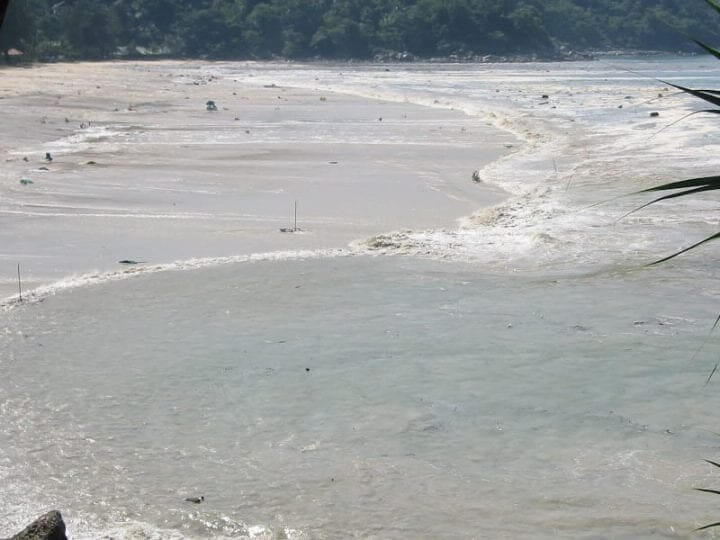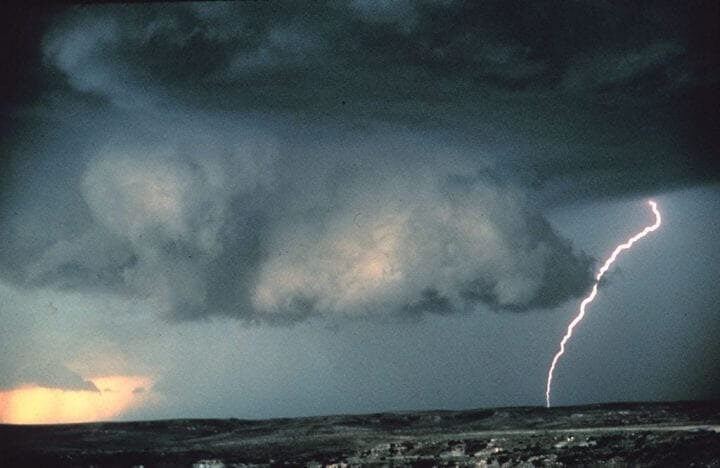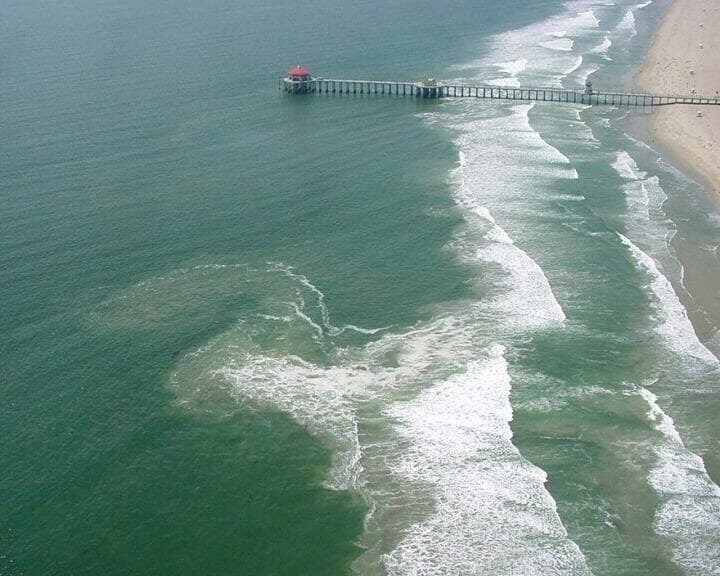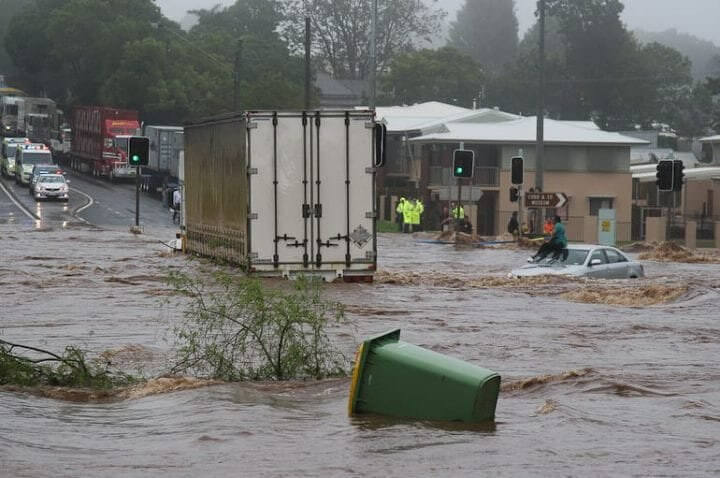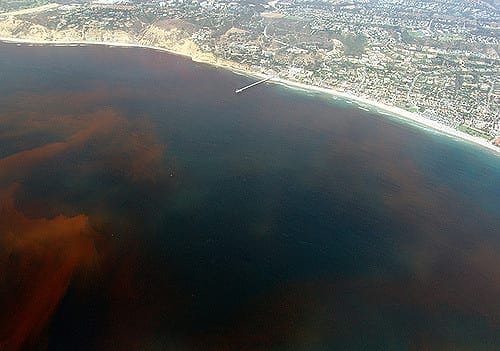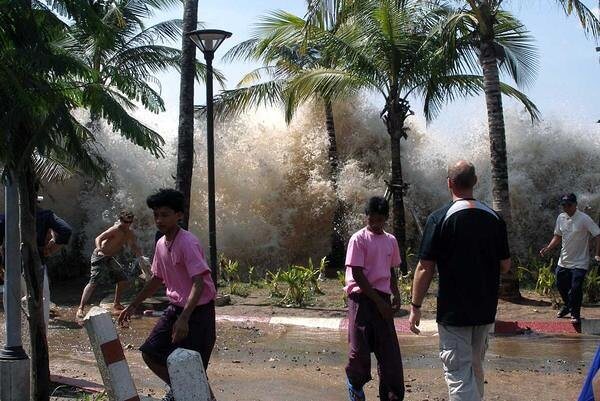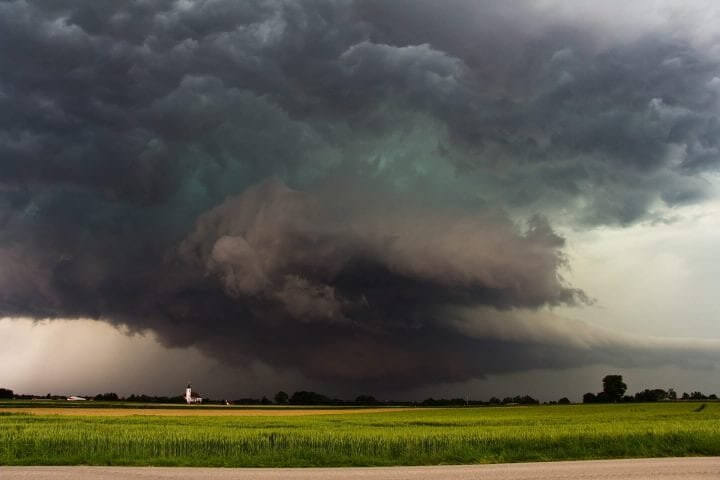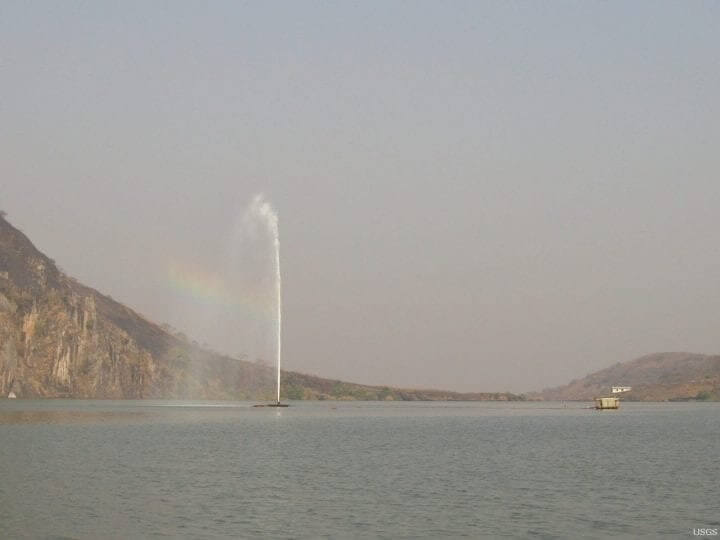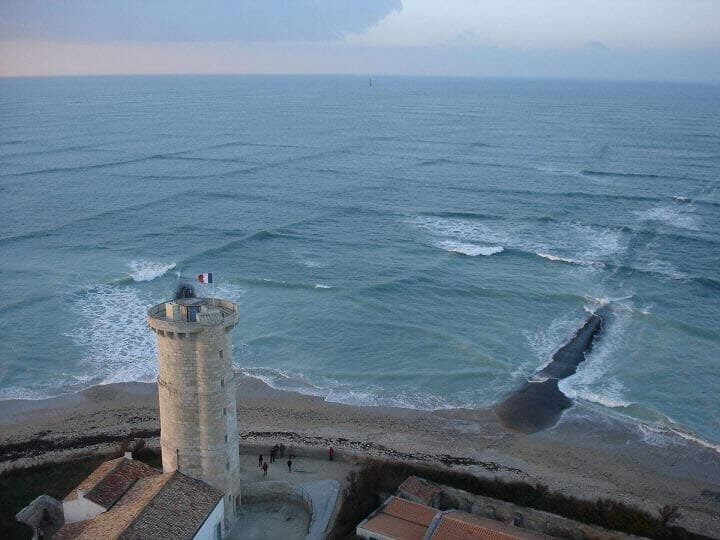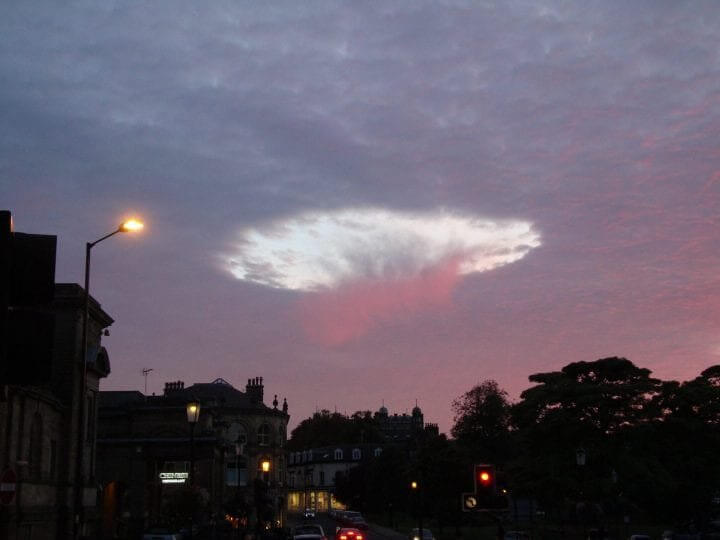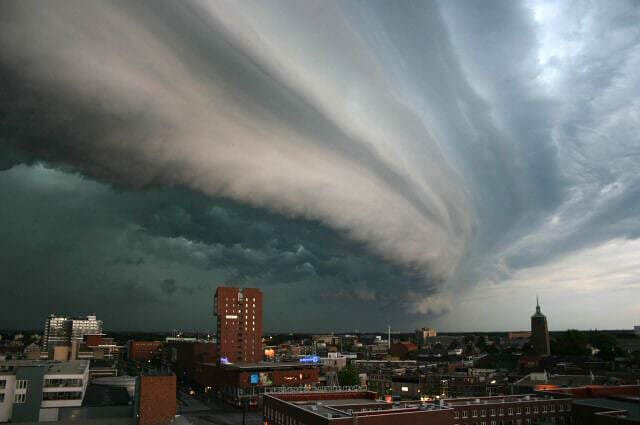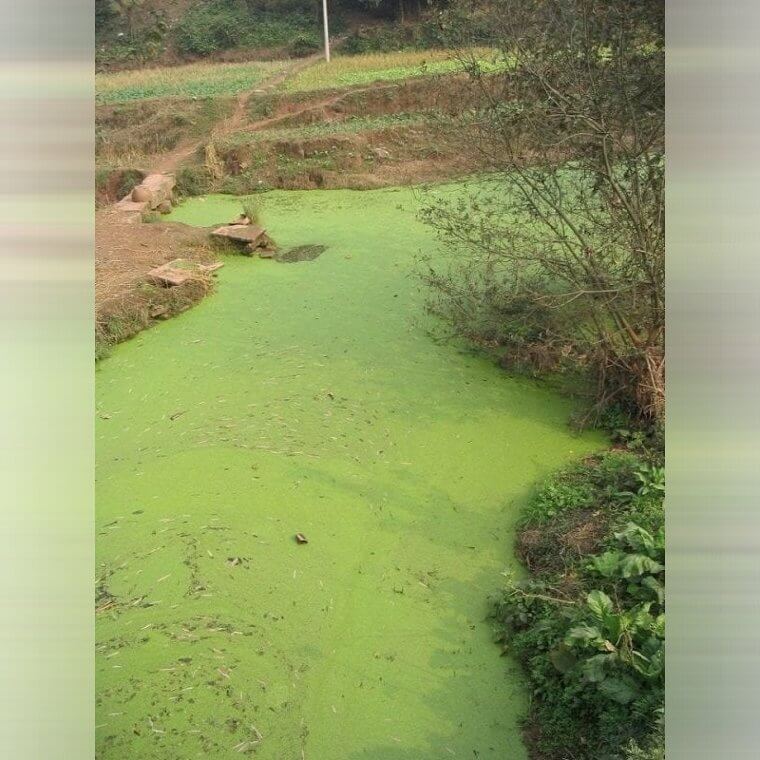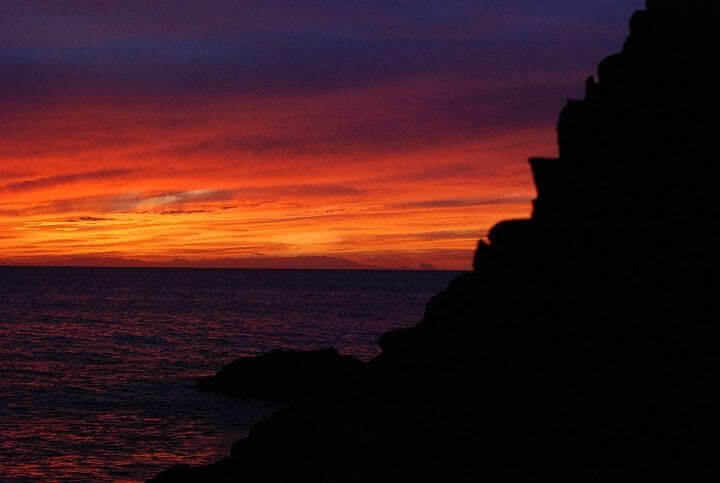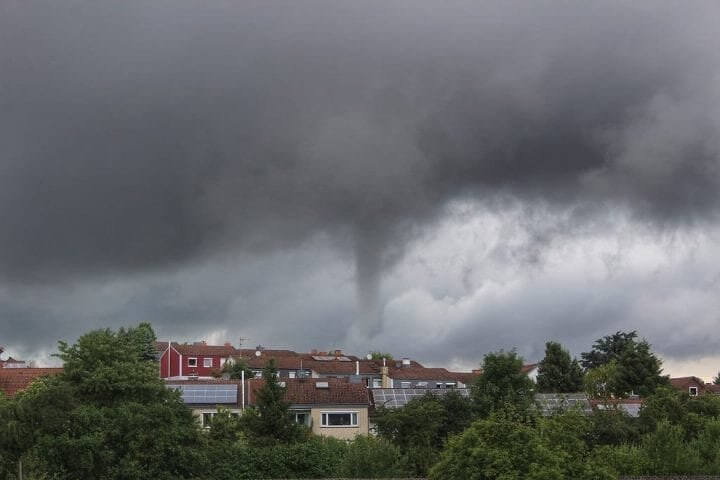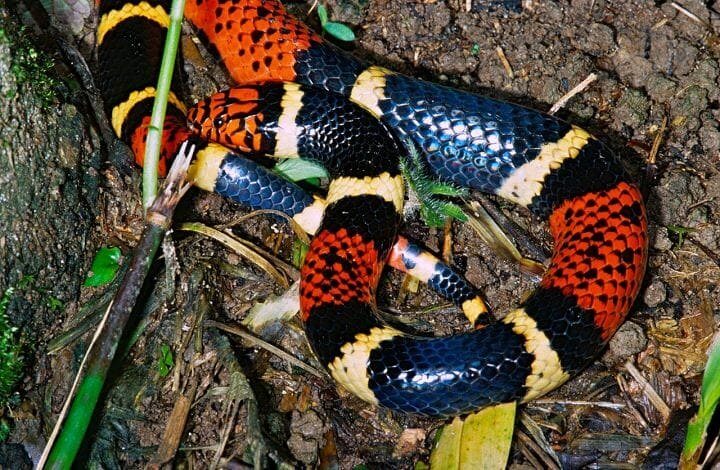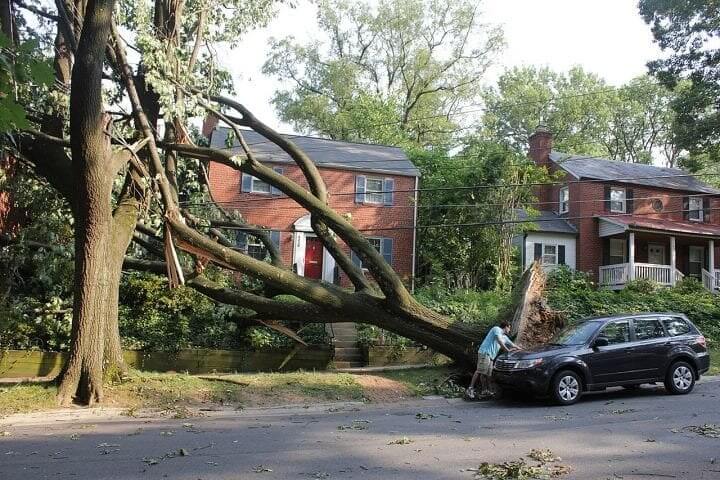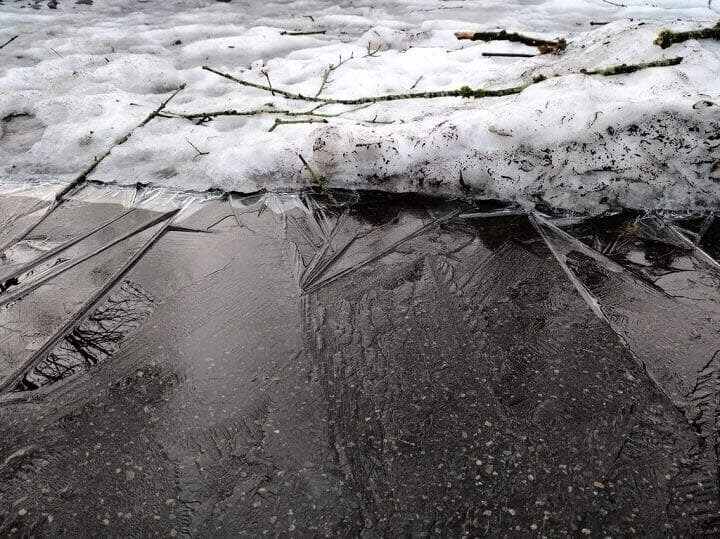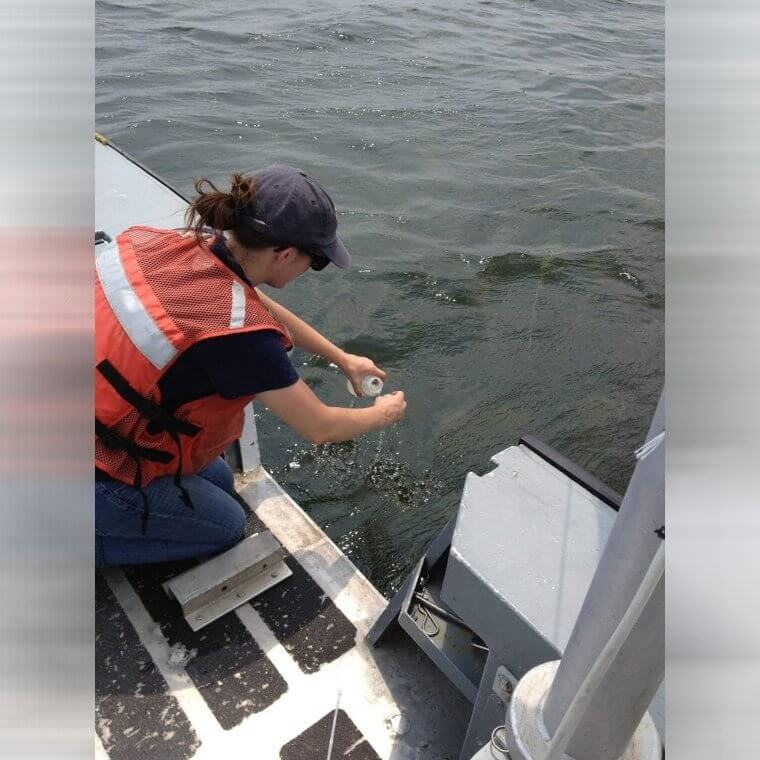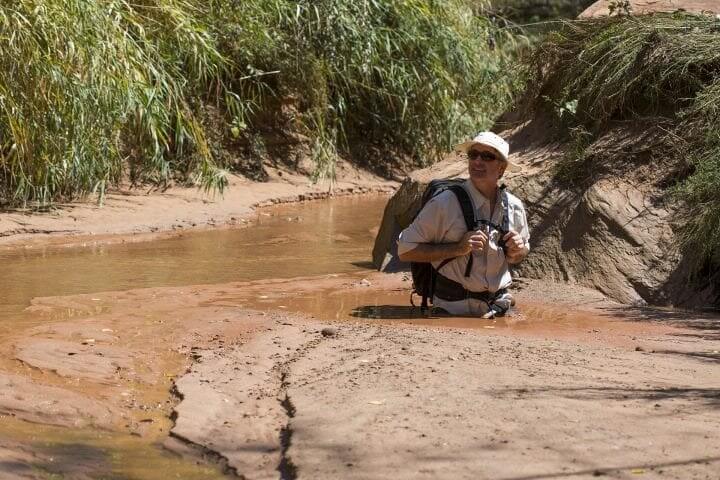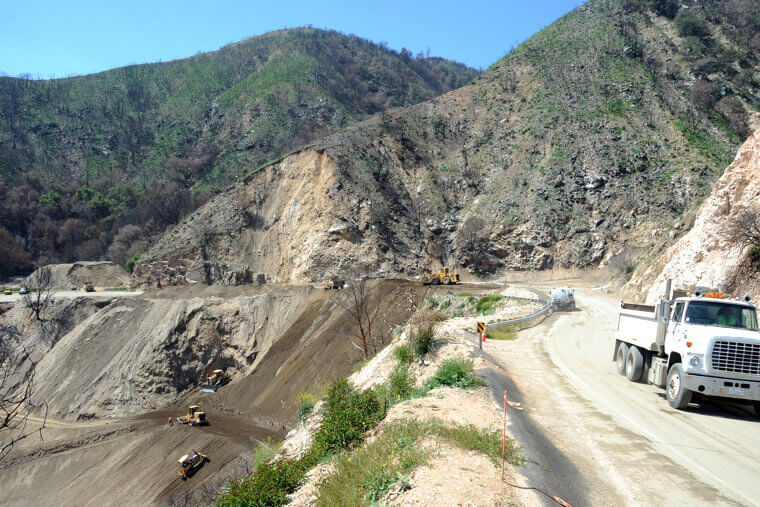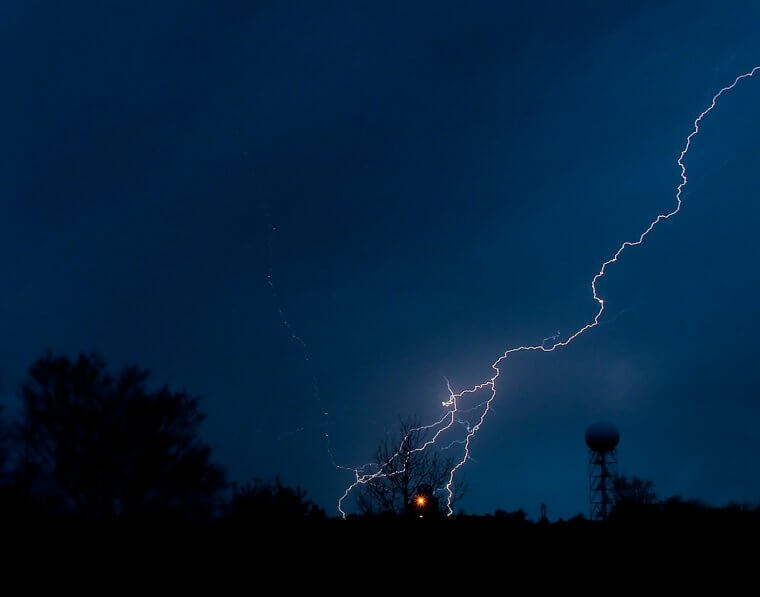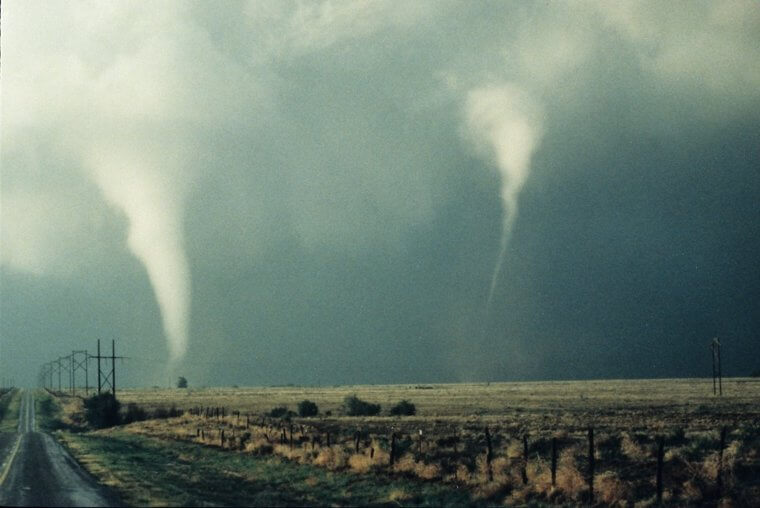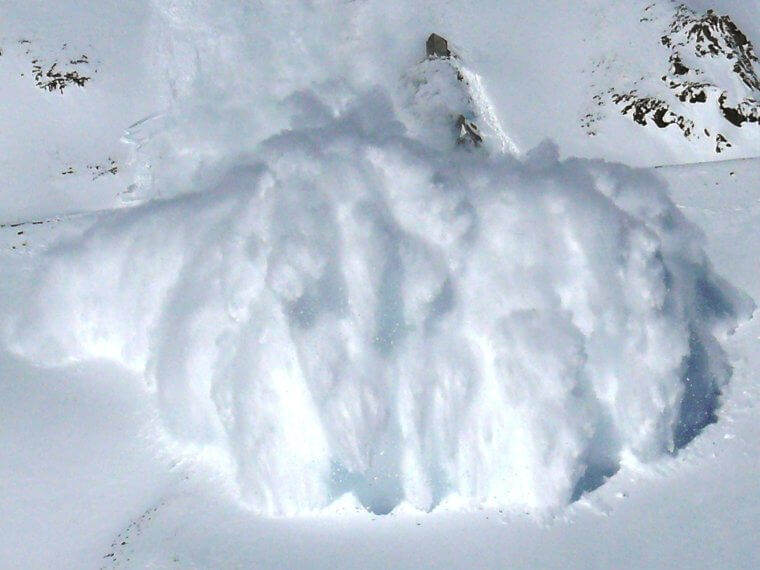Beware of a Patch of J-Shaped Trees on a Slope
Have you ever been hiking in the woods when you saw a patch of trees bent into a J shape? You may have escaped a very dangerous situation since that's a sign of an upcoming landslide. The ground is moving very slowly, making the trees grow in the odd shape.
Another sign of potential landslide is cracking in the ground, which could be in the sidewalk, street, or dirt. Plus, if there was a landslide there before, another one may be on the way. Would-be rescuers have been buried in the second landslide. Landslides occur on slopes, though, so if you’re in a flat area you’re probably fine.
When the Ocean Level Drops, Danger Is Not Far Behind
If you’re walking along the beach in the Ring of Fire, aka the coasts along much of the Pacific Ocean, and the water starts receding, you may be in trouble. Are the coral reefs uncovered? Don’t waste any time looking at flopping fishes or pretty corals, get to high ground as fast as possible. A tsunami is likely on the way.
Tsunamis are usually formed when an earthquake happens underwater, which displaces the water above it. At this point, the waves can move as fast as a jet airplane — 500 miles per hour — across the ocean. You may as well keep a look out for the ocean level dropping along other beaches, because while tsunamis are most common in the Pacific, they happen elsewhere too.
A Wall Cloud in the Sky Might Take You Out of Kansas
Lying on the grass and watching fluffy white clouds may be a calming way to pass the time, but if you find yourself watching a wall cloud, get to shelter. Wall clouds sit lower than the rest of the thunderstorm and can be up to five miles long.
Quickly rising air makes the pressure drop below the storm, forming the wall cloud. But these formations can mean danger, because if the cloud is rotating, it could produce a destructive tornado. As we all learned from the Wizard of Oz, tornadoes can be the start to an amazingly colorful journey, but usually, they’re just bad news.
Steer Clear of the Channel of Choppy Waters at the Beach
If you see a channel of choppy water on the beach, seaweed and debris moving away from the shore in a particular area, a section of discolored water, or a gap in the line of waves, it’s likely that a deadly rip current lies beneath the water’s surface. Commonly (though mistakenly) called riptides, rip currents are very fast, powerful channels of water flowing away from shore.
Rip currents kill over a hundred people in the U.S. every year and are responsible for most lifeguard rescues. You can check rip current risks before heading into the water, but if you do get caught in one, you should swim parallel to the shore to break out of the channel. Then head at an angle to shore. If you're having trouble with that, you should flip, float, and follow. That means flip onto your back and float, then follow the path to safety. That can mean floating with the current until it dissipates.
If Animals Start Leaving, an Earthquake Might Be on the Way
As far back as 373 BC Greece, people have reported that animals like rats, snakes, and insects flee their homes days before a large earthquake shakes the land. But so far these stories are not backed by science. Scientists don’t know what the animals are detecting — if they are actually sensing anything. It's also pretty hard to study their behavior right before an earthquake.
Generally, animals can sense earthquakes a few seconds before humans, because they feel the initial small waves that we can’t detect. But while this could be marginally helpful, it won't tell you to get out of the earthquake zone soon enough.
If You Hear a Roar of Rushing Water, Run to High Ground
If it’s been raining a lot, you’re near a stream or river, and you hear a roar of rushing water, get to high ground immediately. It’s likely that a flash flood is about to spill out in front of you and, considering that floods are the second most deadly form of severe weather (in the U.S.), you don’t want to be caught in it.
Flash floods are incredibly powerful. They can roll boulders, level buildings, uproot trees, and drag bridges. Broken dams, failing levees, and heavy rain can all cause flash floods. Unfortunately, rain is only romantic until it takes away half the road.
If All the Golden-Winged Warblers Disappear, a Storm's Brewing
While it's unclear if animals leave before an earthquake, if all the golden-winged warblers suddenly fly away, it’s possible a severe tornado is on its way. In April 2014, researchers were tracking a group of these birds in Tennessee when suddenly they weren’t in Tennessee anymore.
After checking their geolocators, the scientists realized they’d gone all the way down to Florida. One was actually in Cuba. A few days later, all the birds came back to Tennessee, completing their 900-mile round trip. The scientists think the birds heard low-frequency infrasound coming from the storms. Humans can’t hear infrasound, but birds can.
If You See Fish on the Beach, Don't Go in the Water
One deceased animal on the beach probably means nothing for your health, but if you see a lot of fish or other animals, the water might be toxic. It’s possible that a red tide is congregating in the water near the beach. Red tides happen all over the world, but one algae species causes them in the Gulf of Mexico: Karenia brevis.
When the water is full of more toxic algae than normal, it’s called a red tide. They can make the water reddish or brown, but sometimes the water’s color is normal. If you go in the water, you might experience respiratory irritation like coughing or an itchy throat. Thoroughly rinse off in freshwater and the issues should go away.
Rising Water Levels Warn of an Incoming Flood
If it’s been raining a lot and you see the water level in a stream or river rising, a flood is probably on its way. Plus, the water may be brownish and muddy, from the quick moving water eroding the surrounding sediment.
If you’re ever caught in a flood while driving, stay away from any water on the streets. Turn around and drive away. Even if the water is only two feet deep, it could lift your car and put you in a lot of danger. You'll want to avoid inflicting a flash flood of emotions on your loved ones.
If the Ocean Makes an Unusual Roaring Sound, Get up High
Usually, the ocean has a beautiful and calming sound that plenty of people like to sleep to, but on occasion, it roars like a train. If you hear this unusual sound, chances are that a tsunami is coming toward you. The ocean is dangerous enough without a tsunami rushing at the coast, so get away immediately.
While most tsunamis are caused by underwater earthquakes, a meteorite crashing into the ocean can launch a wave around the world. 3.5 billion years ago, a huge asteroid hit Earth, causing giant tsunamis to roam the oceans. Hopefully, we'll be able to shoot down any asteroids trying to do the same to us.
Green Skies Indicate Severe Weather May Be on the Way
A thunderstorm may appear green because the setting sun’s red light is intermingling with the blue light under the storm. The green color indicates that this thundercloud is extremely tall and warns that a tornado or hail may be coming soon.
If you don’t want to have a scary but colorful dream of a mystical land like Dorothy did, it’s best to get inside and out of the storm. You might want to go to the basement, but only if you won’t feel embarrassed by hiding from what might not be a tornado at all. Otherwise, check the news because the green doesn’t predict anything other than some kind of severe weather.
Beware of Lakes Near Volcanoes in Hot Environments
If a lake is located in a very hot environment that never cools and is near volcanoes, it could be the equivalent of a viciously shaken soda can just waiting to pop. The magma underground might be pushing carbon dioxide into the bottom of the lakes, where there’s a ton of pressure. Since it’s hot year round, the lake never mixes and the gas never gets a chance to escape.
However, if the lake is disturbed by heavy rainfall or maybe an earthquake, it explodes in what is called a limnic eruption. Water bursts out and suffocating carbon dioxide erupts, killing almost everything for miles around it. There are a couple of these lakes in Africa, but once they were identified, people have started degassing them.
If You See Square Waves, Get Out of the Water
This oceanic pattern doesn’t even seem possible, but it occurs when two wave systems run into each other. One of the wave systems continued despite the wind shifting, creating what is called a “cross sea.” But as neat as they may be to look at, they can be incredibly dangerous for ships, surfers, and swimmers.
Underneath the surface of these cross-seas is an exceptionally strong current that can carry you out to sea. The water is also very difficult for boats to navigate, so some ships are wrecked by cross seas. The Isle of Rhe in France is famous for them, but they can be found elsewhere, like in New Zealand.
If You See a Hole in the Sky, Try Not to Get Abducted!
An invasion is in our midst! Fallstreak holes, otherwise known as punch hole clouds, are often attributed to UFOs because they form a large circular gap in clouds that appears as if an alien ship just took-off. They form in mid to high-level clouds made of tiny water droplets surrounded by below-freezing temperatures but have not yet frozen. Airplanes passing through the cloud help the supercooled water droplets freeze.
Air expands and cools as it passes over the wings and the propeller blades, decreasing the temperature within just enough to allow the droplets to freeze. The ice crystals grow and start to fall while causing the water droplets around the ice crystals to evaporate. This leaves a large hole in the cloud with brush-like streaks of ice falling below it.
If You See Bands in the Sky, Get to a Basement
If you’re cloud watching outside and you see long streaks of rotating clouds stretching into the main thunderstorm, don’t call out “it’s a snake” and keep naming shapes. Find shelter. Preferably, get away from windows and in a basement because a tornado might form soon.
These streaks are called “inflow bands” and their presence indicates the storm is drawing in low-level air from far away. They usually stretch to the southeast or south of the storm and are relatively low in the sky. Professional storm spotters look for them to figure out if a tornado will form, so they can warn people in the area.
Don't Go in the Water if It's Green or Smells Bad
If you’re near a river, lake, or ocean and the water is green, scummy, or smells bad, stay out of it. Don’t go in or let your pets or children take a dip. An algal bloom is happening in the water, which means there is a lot more algae than normal thriving near the surface.
The algae may or may not be harmful, so it’s best to just stay out altogether. The toxins can sicken or kill animals and occasionally humans. Often, these blooms are caused by too much fertilizer polluting the water. It’s not going to be a nice swim anyway, with all that green gunk, so just take an algal bloom check on your beach day.
Red Skies Can Predict the Weather, Morning or Night
There’s a common saying that the color of the sky can predict the weather: “Red sky at night, sailor’s delight. Red sky in the morning, sailor’s warning.” But does it have any truth? Yes, a bit. The red color comes from the sunlight bouncing off water vapor and dust particles in the air, which can indicate the weather.
So since weather generally moves from west to east, the time of the red sky can partially predict the coming weather. Red skies at night indicate good weather coming in, because the dust particles generally mean there’s a high-pressure system. However, a red sunrise might show that the good weather is passing and a low-pressure system and storm are on their way in from the west.
If You See a Funnel Cloud in the Sky, Get Inside
While funnel cake brings joy and giddiness, funnel clouds bring fear and danger. They are cone-shaped clouds that protrude out of storms, but don’t touch the ground. Like any cloud, funnel clouds are made of water droplets condensed together. If it’s rotating, the cloud may turn into a tornado.
If the funnel cloud touches the ground, it becomes a tornado. Also, funnel clouds do not cause damage on the ground or make a debris cloud, so if it’s doing that, it’s technically a tornado. However, funnel clouds are only dangerous if they’re made of warm air. Cold air funnels aren’t threatening.
Brightly Colored Animals Often Signal Danger
While we certainly hope you aren’t in the habit of eating random animals in the wild, predators have to do just that. But when they see bright colors like red, orange, or yellow, they know to stay away from that prey. Some animals evolve to have this warning coloration, because they're dangerous and they want predators to know that.
For instance, monarch butterflies are bright orange and can make birds very sick if eaten. Coral snakes, on the other hand, sport bright yellow and red stripes to tell everyone about their venomous bite. But some are false warning signs, like the harmless king snake who has evolved to look like the much scarier coral snake.
A Tree With Deep Cracks or Missing Bark May Be About to Fall Over
A falling tree can be dangerous to your life or your wallet, if it falls on you or anything you own. So, to avoid the damage, check the trees near your house. There are a variety of signs the tree is unhealthy and could fall over. For example, does it have deep cracks in the bark or is it missing sections of bark?
A hole in the trunk, dead or falling branches, and a leaning trunk are all signs something is wrong with the tree. Check to see if it’s losing leaves from the outside. If your tree has these signs, it could be at risk of falling over in strong winds.
Glossy Pavement Can Mean Danger During Winter
All of Key and Peele’s black ice jokes aside, the stuff is a nightmare. Black ice is not black, but particularly clear ice that you can hardly see, which makes it dangerous. It can be dangerous if you’re walking on it and just as bad, if not worse, if you’re driving on it.
Black ice usually occurs when it rains at temperatures near freezing, because the water turns to ice as it hits the cold pavement or sidewalk. So notice the weather before you go driving, to know if you should be extra careful. If the road or sidewalk is glossy in one spot but dry in others, then that’s likely black ice. When driving, stay calm and keep a controlled speed—no sudden accelerating or braking.
Ecosystem Canaries Can Warn Scientists About an Ecosystem's Collapse
While coal miners once used canaries to check for poisonous gasses underground, scientists are now looking to “ecosystem canaries” to check the health of an ecosystem. These species are not canaries, and maybe not even birds at all, but species that have started dying even before the entire ecosystem collapses.
Generally, they reproduce slowly and aren’t great at competing for resources. They aren’t the most crucial parts of the ecosystem, like the keystone species, but they can be a signal of its health. Scientists hope to identify ecosystem canary species, then use them to monitor ecosystems before they are beyond saving.
There's No Real Warning of Quicksand, but You Can Get Out
Perhaps the last time you saw quicksand was in Indiana Jones and the Kingdom of the Crystal Skull, which featured several glaring misconceptions about how it works. The thing is, you can’t drown in quicksand and you shouldn’t grab a rope or snake to pull yourself out.
Quicksand is denser than your body, so while your foot will initially push down the sand, causing the water and clay to close around you, you’ll only sink halfway down. Now, if the tide comes in, that’s where the danger of drowning comes in. So, to get out, you have to wiggle your leg a bit and calmly step up. Getting horizontal will help and at some point, you should float back to the top. It's possible that if the quicksand has gaseous bubbles in it, you will actually be denser than the quicksand and sink. Maybe.
If the Levels of a Nearby Creek Change Drastically, a Landslide Could Be Brewing
Landslides often occur after a lot of rainfall. Creeks help siphon the water into larger bodies, but they can become overwhelmed by torrential rainfall. If the water levels of a creek suddenly increase drastically, more nearby soil is becoming saturated with water, which makes it less solid.
By contrast, if a creek's water level drops drastically, that could be a sign that it's path got diverted due to a change in earth formation or blockage. That means a lot of water is getting into soild that is usually dry, and the intregirty of weigh support can shift. These are prime conditions for a landslide.
Long, Wispy Clouds Could Mean a Hurricane Is Coming
If you see long, wispy clouds that look as though they are all being pulled in the same direction, you may want to get farther inland. That's because those clouds really are getting pulled in – into a hurricane.
As the hurricanes winds builds, it begins to pick up more and more atmospheric moisture, much the same way a vendor spins cotton candy onto a stick (except way, way more dangerous). Just stay calm and start making moves – you still have time. These clouds tend to appear about 36 hours ahead of the hurricane. Unless the hurricane dissipates, those wispy clouds will be replaced with thick bands of rainclouds 24 hours later.
If You're Near a Volcano and Smell Rotten Eggs, Get Away From the Volcano
Before a volcano erupts, molten lava moves underneath. This seismic shift often leads to cracks in the ground on the volcano and a radius around its base.

These cracks allow the steam from the hot lava to escape, which relieves some of the pressure. That gas has a lot of volcanic ash present, which contains hydrogen sulfide. The sulfuric smell is reminiscent of rotten eggs. If you smell it, things are brewing. While it's not a surefire sign, we don't recommend sticking around to find out.
If You Get a Metallic Taste in Your Mouth in a Storm, Run for Cover
But to be honest, it might already be too late. Many people who have been struck with lightning in the past have reported that right before it happened, they have a metallic taste in their mouth. The highly charged air is reacting with the spit in your mouth.
By the time this happens, you probably already have an electrical current moving through your body. Find cover from the open sky and don't touch anything metal.
Large Hail Precedes Tornados
Hail is the product of strong updraft winds through a cool zone of sub freezing temperatures. In superstorms, this process can be strengthened significantly. This can lead to large, dry hail (hail is often interspersed with water – but in superstorms, all the water can freeze together.
If you find yourself in an area where dry, large hail starts to fall, you should find steady shelter immediately. This kind of hail often is the product of the amplification of the updraft-freezing process that only a very powerful thunderstorm can bring – the same kind of thunderstorm that brings mass tornados.
Warm Weather After Heavy Snowfall
Every skiier's dream is to hit fresh powder after a windfall of snow on a beautiful, sunny day. But the combination of warm weather with fresh snow can be dangerous. The surface snow, which is exposed to the warmer weather, partially melts together and forms a slab, which is heavier and more mobile.
If you haven't guess by now, these conditions – especially when accompanied by another fresh layer of powder, make for perfect avalanche conditions. Always check for reports of avalanches in advance of hitting the slopes!


